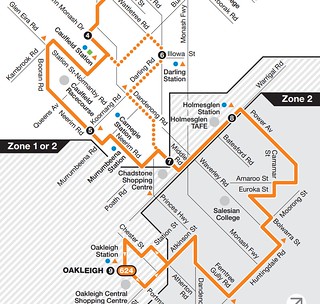 Slow, meandering bus routes are costing Melburnians time and money, the Public Transport Users Association (PTUA) said today.
Slow, meandering bus routes are costing Melburnians time and money, the Public Transport Users Association (PTUA) said today.
A new study released by the PTUA has found that Melbourne buses follow very indirect routes compared to well-designed networks, and the bus system is falling well short of its potential to relieve congested roads and car parks.
“Most of Melbourne is beyond an easy walk to the train or tram, and many journeys don’t follow the rail lines, so buses are the only public transport option for many people,” said PTUA President Daniel Bowen. “Unfortunately slow and infrequent services mean they are often not a real option, and the result is heavier car traffic, overflowing car parks, and higher fuel bills.”
The PTUA study compared the actual route distances travelled by Melbourne’s buses to the shortest, most direct routes possible. On average, bus routes were 70% longer than the direct alternative, while best practice guidelines recommend routes should deviate by no more than about 30% from the most direct route.
Some 20% of Melbourne bus routes were so indirect that the route length was more than double the shortest distance by road.
“Indirect routes take longer for passengers, and need more buses and more drivers for the same service frequency,” said Mr Bowen. “So meandering bus routes mean long waiting times and then slow journeys. It’s no wonder Melbourne buses attract fewer passengers than buses in other cities – and indeed fewer passengers than Melbourne’s tram and train services, which provide much more direct routes.
“Short diversions to better serve interchanges or major destinations make sense, but many of Melbourne’s buses are so indirect that they result in an incomprehensible, spaghetti-like route structure, which not only makes it slow to travel even relatively short distances, but is also difficult to navigate.
The report found routes were particularly bad in western Melbourne where rapid population growth was fuelling transport concerns. “While the government is pursuing a massively expensive east-west motorway, most of western Melbourne is crying out for usable public transport,” said Mr Bowen. “Regional Rail Link will still leave people reliant on their cars if they can’t get a bus to local destinations or the new railway stations.
“The way forward is more direct, more understandable bus routes such as Smartbus, that provide fast, frequent services and a genuine alternative to car travel.”
- Driven around the bend – Melbourne’s meandering bus routes — full report, 1.1Mb PDF
- See also: The Age 8/6/2012: Revamp to get buses up to speed

